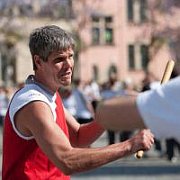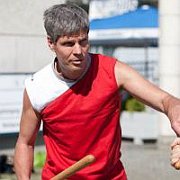|
WTW,
4/29/2011 Escrima Consultation Hours WTW: Why should I worry about distance at all? Master Thomas Dietrich: Why you should think about it? Simply, because this isn't just your business. It depends on both the attacker and the attacked one. And it depends on what you're trying to attack. There's two flavours of attacks: One to attack and one to counter an attack. If you want to attack to attack, you have to break into your opponent's distance. In case you're attacking to counter an attack, the other guy is entering your distance. What's the correlation to our basics, the foundation of our Escrima? In general, when you're exercising on your own you need to pay attention to the basics called speed, power, timing, and balance. It's those four that are your very own business. This changes immediately as soon as your opponent enters the ring: Then it's all about focus and distance first which always add to the rest. It means you have to watch closely what's happening, since things will tell you what to do, where to go to and which target to pick. It might as well be which target you're after generally - not just the aim of your current attack but rather the target of your actions in general.
Absolutely! A negative example when ignoring this could be that I'm always hitting too short in class just not to hurt my partner. But in reality I will be in big trouble when I actually need to hit on target! What's the most important part of an attack? The target. What's the most important part of a target? To hit it. What's the most important part of hitting something? To get somewhere with my plan. Period. Simple as that. No ifs, no buts... What does distance mean in Newman-Escrima? The same as it does in any other marital art: Being able to hit your opponent but not getting hit by your opponent. That means, distance also depends on the type of weapon I'm using. Correct! How do I find my right distance to my opponent? Write down exactly what I'm going to tell you now: There's an excellent book I highly recommend. It's got 1003 pages and it's called "The Art Of Learning". On its first page it says in bold letters "practise". On its second page it says in bold letters "practise". On page #500 it says "practise", too, as well as it does on page #501. And on its last page you can read "now start practising properly". It's all about experience. There's no trick or infusion which would enable you in an instance. Using a CAD programme I could easily depict starts, targets, angles, distances and explain why one can reach its target and the other won't, even if both have arms of the same length. I can test constantly if I'm doing it right when I aim my weapon at you, like doing a stab and touching your chest slightly with it. That's distance. I can hit you, no doubt. Inside this distance I have to stay behind my weapon at all times. And inside this distance you have to keep up our principles: Will I counter an attack then I have to move my body first. Will I attack to attack, my weapon goes first. Anything outside this distance doesn't matter. I don't have to stick behind my weapon when I'm still 60 ft. away from my opponent. Nonsense. When does it get critical for me? Once you can get hit. When your opponent reaches out for you and is able to hit you. Then it's getting serious and you have to remember: Weapon first when I'm attacking. Body first when I'm countering. When my training partner is considerably taller, I'm having a hard time, always. It's getting critical much earlier for me than for him, doesn't it? For about half a nano second, if you're quick. Don't forget: A long muscle moves slower than a short one. The smaller the muscle, the quicker it can move. The bigger, the slower. How can I develop my sense of distance? As I said before - practise and exercise. Practising in a controlled way is key, like skipping the counter attack. I do allow my training partner to hit me so he can verify his distance. Which brings us back to the other basics, one of them is "speed". Should I exercise quick and fast with a beginner? No, I shouldn't, because a beginner does not have control over his actions. Beginners are still insecure in what they're doing. They get scared and nervous easily. Balance is off, wrong distance. Which turns everything I'm practising into something useless and wrong. Again, during an exercise it is perfectly right not to counter. Which means even though I'm in the right distance, I allow my partner to hit me. I can quickly verify if that attack would have hit me at all. Allowing someone to hit me is a matter of trust. I have to trust my students and training partners. They have to control themselves otherwise they hurt me. This is an important message of the offlining exercise. When do we get problems with distance? Usually there's problems when trying to keep the right order, i.e. the correct timing, when attacking to attack or when attacking to counter. I need the right distance, my weapon has to be between me and my opponent once I'm entering his distance. While I'm still not able to hit him without stretching my arm completely (which I'd like to avoid), I have to bridge this gap of approx. 8 inches by applying proper footwork. Then I'm able to hit on target.
OK, let me recap, I'm approaching my opponent, entering his striking distance and then...? Then you have to be behind your weapon otherwise you'd be easy prey. By this point your backswing must be finished and you must launch your strike. It is important that you're no longer in a backwards motion with your own weapon once your opponent is within striking range. That's crucial. As soon as you can hit me, I must no longer swing back my weapon. But this is what most students still do: They rush in during their backswing and get hit... How can I practise distance? The path of learning is made up by our programmes. They're like a ladder. And while climbing up that ladder you should have internalised all those basics in a way you're able to apply them to any kind of weapon. You should be able to handle a long, light-weighted weapon the same skilled way as a short and heavy one. Does distance affect my attitude? Not really. But my opponent's weapon does affect my attitude, if it's completly different than mine. I have to change my approach when my opponent is armed and I'm not or his weapon is longer than mine (like he's using a stick while I'm only having a ballpen). I am forced to adapt my attitude and approach for this encounter. I can't let him strike four, five, or even six times - I have to end this situation quickly, maybe even by disarming him to use his own weapon against him. Is there any such thing like a "mental distance"? By all means. In psychology the term is called "proximity behaviour" or more general "personal space". In a fight situation I do have a "distance of respect" to my opponent. Same counts for work, with my boss. I don't get too close with him, out of respect. In other words, I approach a person of respect completely different as I would approach a good friend or a long-time training partner. This is obvious stuff. On the street I have respect for my opponent, at least. I might be even scared of him. This "mental pressure" correlates to distance. What do you find fascinating about distance? The fact that it's so incredibly hard to learn. The fact that I'm still in the phase of learning it. The fact once I go "that's it, now I know!" I'm getting non-credible. I tend to say I'm a learner for life. Stopping to learn or standing still is actually regression. There's no more progress. Any new influences and impacts won't be noticed any more. Everything would stop being so much fun and would not be that exciting any longer. Text: jn |
|||||||
 Master
Thomas Dietrich a.k.a "Doc" is not just known for his precise
analysis of movements. During an interview he was also giving lectures
on distance, split seconds and one of the most fascinating books of
all times. For WTW "Doc" writes out a special prescription.
Master
Thomas Dietrich a.k.a "Doc" is not just known for his precise
analysis of movements. During an interview he was also giving lectures
on distance, split seconds and one of the most fascinating books of
all times. For WTW "Doc" writes out a special prescription. So
distance is relevant whenever I'm facing an opponent?
So
distance is relevant whenever I'm facing an opponent?


